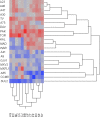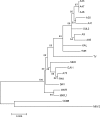Comparative analysis of myxococcus predation on soil bacteria
- PMID: 20802074
- PMCID: PMC2953020
- DOI: 10.1128/AEM.00414-10
Comparative analysis of myxococcus predation on soil bacteria
Abstract
Predator-prey relationships among prokaryotes have received little attention but are likely to be important determinants of the composition, structure, and dynamics of microbial communities. Many species of the soil-dwelling myxobacteria are predators of other microbes, but their predation range is poorly characterized. To better understand the predatory capabilities of myxobacteria in nature, we analyzed the predation performance of numerous Myxococcus isolates across 12 diverse species of bacteria. All predator isolates could utilize most potential prey species to effectively fuel colony expansion, although one species hindered predator swarming relative to a control treatment with no growth substrate. Predator strains varied significantly in their relative performance across prey types, but most variation in predatory performance was determined by prey type, with Gram-negative prey species supporting more Myxococcus growth than Gram-positive species. There was evidence for specialized predator performance in some predator-prey combinations. Such specialization may reduce resource competition among sympatric strains in natural habitats. The broad prey range of the Myxococcus genus coupled with its ubiquity in the soil suggests that myxobacteria are likely to have very important ecological and evolutionary effects on many species of soil prokaryotes.
Figures




Similar articles
-
Decomposing predation: testing for parameters that correlate with predatory performance by a social bacterium.Microb Ecol. 2013 Feb;65(2):415-23. doi: 10.1007/s00248-012-0135-6. Epub 2012 Nov 27. Microb Ecol. 2013. PMID: 23184156 Free PMC article.
-
Characterization of Two Novel Predatory Bacteria, Bacteriovorax stolpii HI3 and Myxococcus sp. MH1, Isolated from a Freshwater Pond: Prey Range, and Predatory Dynamics and Efficiency.Microorganisms. 2022 Sep 10;10(9):1816. doi: 10.3390/microorganisms10091816. Microorganisms. 2022. PMID: 36144418 Free PMC article.
-
[Influence of different prey strains on isolation myxobacteria in saline-alkaline soils of Xinjiang].Wei Sheng Wu Xue Bao. 2013 Apr 4;53(4):379-89. Wei Sheng Wu Xue Bao. 2013. PMID: 23858713 Chinese.
-
Myxococcus xanthus predation: an updated overview.Front Microbiol. 2024 Jan 24;15:1339696. doi: 10.3389/fmicb.2024.1339696. eCollection 2024. Front Microbiol. 2024. PMID: 38328431 Free PMC article. Review.
-
The Genetics of Prey Susceptibility to Myxobacterial Predation: A Review, Including an Investigation into Pseudomonas aeruginosa Mutations Affecting Predation by Myxococcus xanthus.Microb Physiol. 2021;31(2):57-66. doi: 10.1159/000515546. Epub 2021 Apr 1. Microb Physiol. 2021. PMID: 33794538 Review.
Cited by
-
Antibiotics from predatory bacteria.Beilstein J Org Chem. 2016 Mar 30;12:594-607. doi: 10.3762/bjoc.12.58. eCollection 2016. Beilstein J Org Chem. 2016. PMID: 27340451 Free PMC article. Review.
-
Killer prey: Ecology reverses bacterial predation.PLoS Biol. 2024 Jan 23;22(1):e3002454. doi: 10.1371/journal.pbio.3002454. eCollection 2024 Jan. PLoS Biol. 2024. PMID: 38261596 Free PMC article.
-
Thiocillin contributes to the ecological fitness of Bacillus cereus ATCC 14579 during interspecies interactions with Myxococcus xanthus.Front Microbiol. 2023 Nov 24;14:1295262. doi: 10.3389/fmicb.2023.1295262. eCollection 2023. Front Microbiol. 2023. PMID: 38075900 Free PMC article.
-
Both Soil Bacteria and Soil Chemical Property Affected the Micropredator Myxobacterial Community: Evidence from Natural Forest Soil and Greenhouse Rhizosphere Soil.Microorganisms. 2020 Sep 10;8(9):1387. doi: 10.3390/microorganisms8091387. Microorganisms. 2020. PMID: 32927762 Free PMC article.
-
Community Profile and Drivers of Predatory Myxobacteria under Different Compost Manures.Microorganisms. 2021 Oct 21;9(11):2193. doi: 10.3390/microorganisms9112193. Microorganisms. 2021. PMID: 34835319 Free PMC article.
References
-
- Abrams, P. A. 2000. The evolution of predator-prey interactions: theory and evidence. Annu. Rev. Ecol. Syst. 31:79-105.
-
- Abrams, P. A. 1999. Is predator-mediated coexistence possible in unstable systems? Ecology 80:608-621.
-
- Bell, G. 1990. The ecology and genetics of fitness in Chlamydomonas. 1. Genotype-by-environment interaction among pure strains. Proc. Biol. Sci. 240:295-321.
Publication types
MeSH terms
Substances
Associated data
- Actions
- Actions
- Actions
- Actions
- Actions
- Actions
- Actions
- Actions
- Actions
Grants and funding
LinkOut - more resources
Full Text Sources
Molecular Biology Databases

